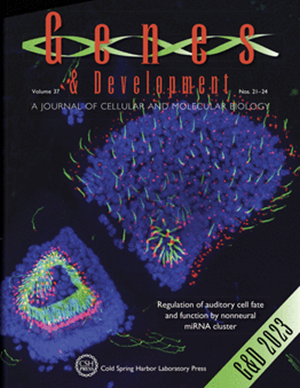An imbalance between proliferation and differentiation underlies the development of microRNA-defective pineoblastoma
IF 7.7
1区 生物学
Q1 CELL BIOLOGY
引用次数: 0
Abstract
Mutations in the microRNA processing genes DROSHA and DICER1 drive several cancers that resemble embryonic progenitors. To understand how microRNAs regulate tumorigenesis, we ablated Drosha or Dicer1 in the developing pineal gland to emulate the pathogenesis of pineoblastoma, a brain tumor that resembles undifferentiated precursors of the pineal gland. Accordingly, these mice develop pineal tumors marked by loss of microRNAs, particularly the let-7/miR-98-5p family, and derepression of microRNA target genes. Pineal tumors driven by loss of Drosha or Dicer1 mimic tumors driven by Rb1 loss, as they exhibit upregulation of S-phase genes and homeobox transcription factors that regulate pineal development. Blocking proliferation of these tumors facilitates expression of pinealocyte maturation markers, with a concomitant reduction in embryonic markers. Select embryonic markers remain elevated, however, as the microRNAs that normally repress these target genes remain absent. One such microRNA target gene is the oncofetal transcription factor Plagl2, which regulates expression of progrowth genes, and inhibiting their signaling impairs tumor growth. Thus, we demonstrate that tumors driven by loss of microRNA processing may be therapeutically targeted by inhibiting downstream drivers of proliferation.增殖和分化之间的不平衡是微rna缺陷松果体母细胞瘤发生的基础
microRNA加工基因DROSHA和DICER1的突变驱动了几种类似胚胎祖细胞的癌症。为了了解microrna如何调节肿瘤发生,我们切除了发育中的松果体中的Drosha或Dicer1来模拟松果体母细胞瘤的发病机制,松果体母细胞瘤是一种类似于松果体未分化前体的脑肿瘤。因此,这些小鼠发展为松果体肿瘤,其特征是microRNA的缺失,特别是let-7/miR-98-5p家族的缺失,以及microRNA靶基因的下调。Drosha或Dicer1缺失导致的松果体肿瘤类似于Rb1缺失导致的肿瘤,因为它们表现出调节松果体发育的s期基因和同源盒转录因子的上调。阻断这些肿瘤的增殖可促进松果体细胞成熟标记物的表达,并伴随胚胎标记物的减少。然而,由于通常抑制这些靶基因的microrna仍然缺失,选择的胚胎标记物仍然升高。其中一个microRNA靶基因是癌胎转录因子Plagl2,它调节促生长基因的表达,抑制促生长基因的信号传导会损害肿瘤的生长。因此,我们证明了由microRNA加工缺失驱动的肿瘤可能通过抑制增殖的下游驱动因子而成为治疗靶点。
本文章由计算机程序翻译,如有差异,请以英文原文为准。
求助全文
约1分钟内获得全文
求助全文
来源期刊

Genes & development
生物-发育生物学
CiteScore
17.50
自引率
1.90%
发文量
71
审稿时长
3-6 weeks
期刊介绍:
Genes & Development is a research journal published in association with The Genetics Society. It publishes high-quality research papers in the areas of molecular biology, molecular genetics, and related fields. The journal features various research formats including Research papers, short Research Communications, and Resource/Methodology papers.
Genes & Development has gained recognition and is considered as one of the Top Five Research Journals in the field of Molecular Biology and Genetics. It has an impressive Impact Factor of 12.89. The journal is ranked #2 among Developmental Biology research journals, #5 in Genetics and Heredity, and is among the Top 20 in Cell Biology (according to ISI Journal Citation Reports®, 2021).
 求助内容:
求助内容: 应助结果提醒方式:
应助结果提醒方式:


